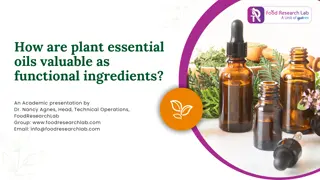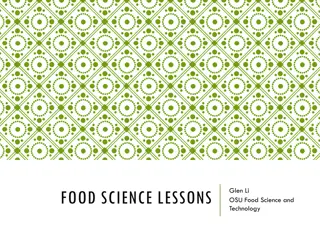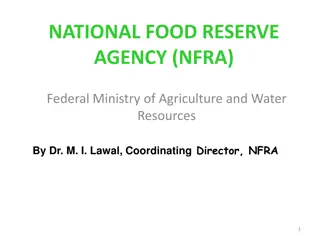The Challenge of Food Insecurity and Malnutrition
Humans transitioned from hunting/gathering to agriculture, leading to overproduction of food globally. Despite this, around 1 billion people suffer from food insecurity due to poverty, unequal distribution, political factors, and natural disasters. Malnourishment and undernourishment remain prevalent, impacting growth and development. Nutritional requirements, including caloric intake and protein sources, are essential for feeding a growing population. The imbalance in food distribution, with a significant portion going towards animal feed, highlights the complexities of addressing hunger on a global scale.
Uploaded on Dec 12, 2024 | 0 Views
Download Presentation

Please find below an Image/Link to download the presentation.
The content on the website is provided AS IS for your information and personal use only. It may not be sold, licensed, or shared on other websites without obtaining consent from the author. Download presentation by click this link. If you encounter any issues during the download, it is possible that the publisher has removed the file from their server.
E N D
Presentation Transcript
Humans and Nutrition Approximately 10,000 years ago humans stopped relying on hunting/gathering techniques and started to grow their own food (farming). Today the most common method of gathering food is going to the store or market and purchasing what you need and want. But the food in the stores came from somewhere. Agriculture is one of the most abundant industries in the world. ~38% of all arable land is used in agriculture (meat and crops). World wide, we have an overproduction of food . Then why are so many people starving? There are about 1billion people worldwide who do not get enough food to eat.
Humans and Nutrition Food Security/Insecurity: Having/not having access to foods that are nutritious and dietetically sound and safe. Either economically, socially, and physically All farmers grow enough grain to feed 8 billion people. Grain is the most abundant dietary food available worldwide, but it is only a little more than of the food we produce. Most of the worlds food is produced in the US, Europe/Asia and parts of S. America. Some of the reasons why people are still starving: Poverty many countries/or groups of people that do not have arable land are poor and can not afford to purchase enough food to sustain them. (unequal food distribution) Political and economic factors Refugees, people displaced by natural disasters (ie Japan) do not have access to food. Poor people often resort to violence or crime because they are hungry and want to provide for themselves or family members. Rise in food prices only countries and people in developed countries are able to afford the costs of transporting food items. There are two types of starvation: malnourished and undernourished
Food and Nutrition Malnourished Undernourished Lacking a sufficient amount of protein and other nutrients (vitamins/minerals) Not eating enough calories that can be converted into cellular energy Continual undernourishment is when a person is deprived of energy for daily living and activities. ~1/2 world is malnourished regardless of calories consumed (usually grains) Leads to: Kwashiorkor -lack of sufficient types of proteins especially during infancy causing underdevelopment of muscles and brain tissue Leads to: stunted growth, brain damage, social development disorders and Marasmus (emaciation due to lack of protein).
Food and Nutrition Feeding a growing population: Nutritional requirements 2500 calories/day/male 2000 calories/day/female Protien 30% of caloric diet Carbs 60% of caloric diet Fats <10% of caloric diet 100 spp of plants are commercially grown to meet human nutritional needs out of 350,000. 3 main types: wheat, rice and corn Wheat and rice of human caloric intake worldwide Corn main nutritional supplement for feed industry
Food & Nutrition Cont. 8 spp of animal protein supply 90% of the world s meat. Takes 16lbs of grain to produce 1lb of meat. 20% of the world s richest countries consume 80% of the world s meat production. 90% of U.S. s grain is used for animal feed.
Agriculture Main Types: (we will be discussing each in detail) Industrial Organic Plantation Subsistence Monoculture Polyculture
Agriculture Industrial Agriculture: High yield/ High In-put agriculture. Usually from large scale monocultures. Use of heavy equipment, fossil fuels, water, commercial fertilizers and pesticides. Large financial capital is involved. Produces ~80% of the world s food. Plantation Agriculture: Industrialized Tropical agriculture Mainly in LEDCs Cash crops such as bananas, soybeans, sugarcane, coffee, palm oil, and vegetables.
Agriculture Traditional Agriculture: (Polyculture) Two types Subsistence farming growing and harvesting enough food for your family to survive. With little extra for sale or storage. Intensive Farming subsistence with the intent of increasing yield for capital gain. Using fertilizer, water and pest control, labor (human and animal). Slash-and-burn - type of subsistence used to increase land area of trees and brush in tropical forests for crops and animals. Within a few years depletion of nutrients in soil will cause the people to abandon the land and leave it fallow if not shown how to grow sustainably.
C:\Program Files\Microsoft Office\MEDIA\CAGCAT10\j0233312.wmf Agriculture Seed Security: Green Revolution - in the 50 s scientists came up with a way to make a genetically modified seed (GMO). In this they were able to make a higher yield on crops in a smaller amount of land. - seeds were better resistant to pests, weather and other ailments. - this led to the industrial agriculture we know today. - Large corporations then patented the seeds and bought farmers to grow them. In a monocultural farm community. - In the 60 s and 70 s many farmers and environmentalists started to rebel against the process of GMOs and Industrial farming with lots of corporate backlash. Which led to organic farming methods being used once again in smaller areas and a way of life for many (tree huggers) naturalists. - Today the process of the Green Revolution is still in affect. Corporations are still controlling the seed industry and most of the farming practices in the US. Which can cause the soil to be depleted of nutrients and higher cases of contamination in crops as pests and diseases become immune to pesticides and fertilizers.























